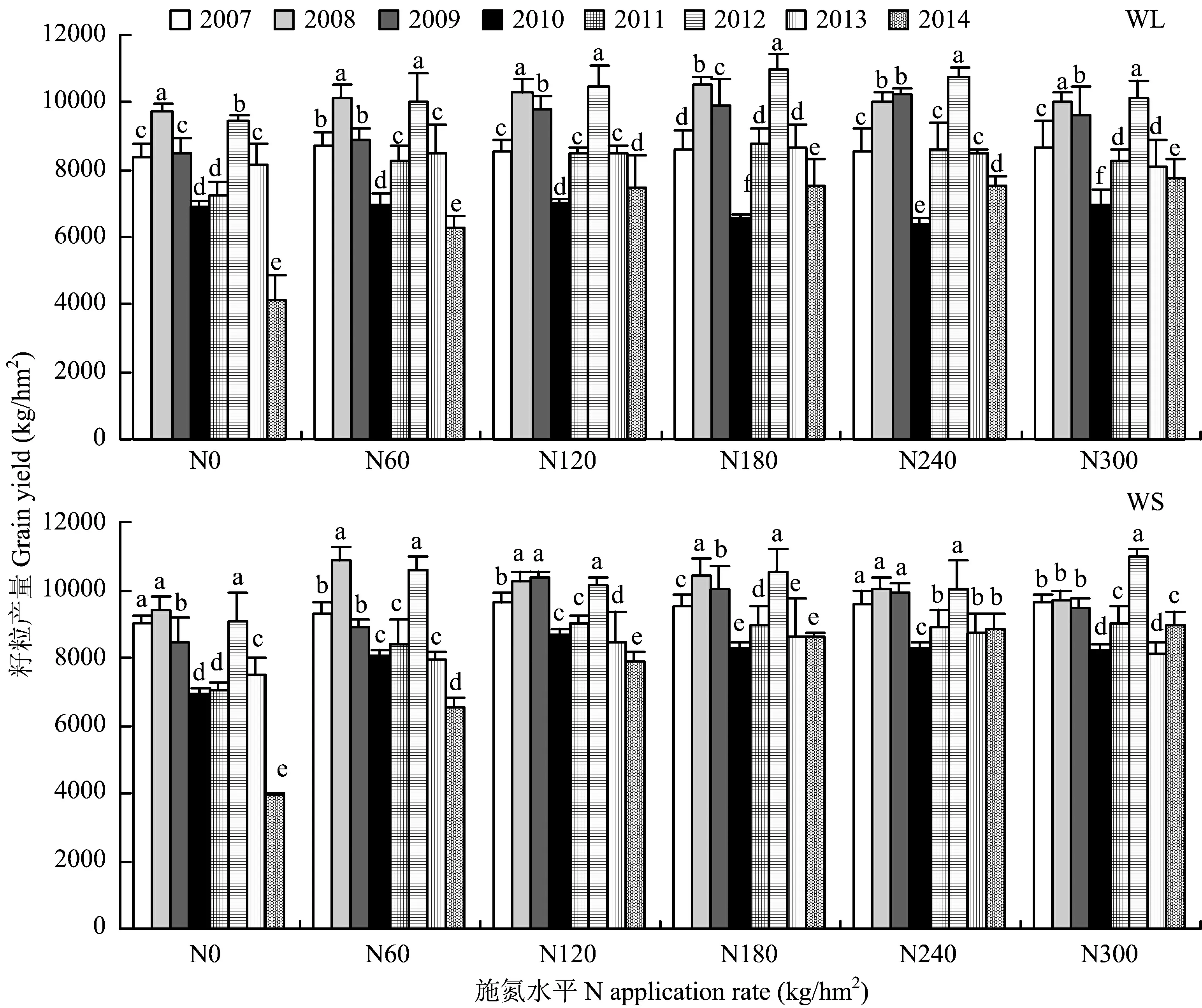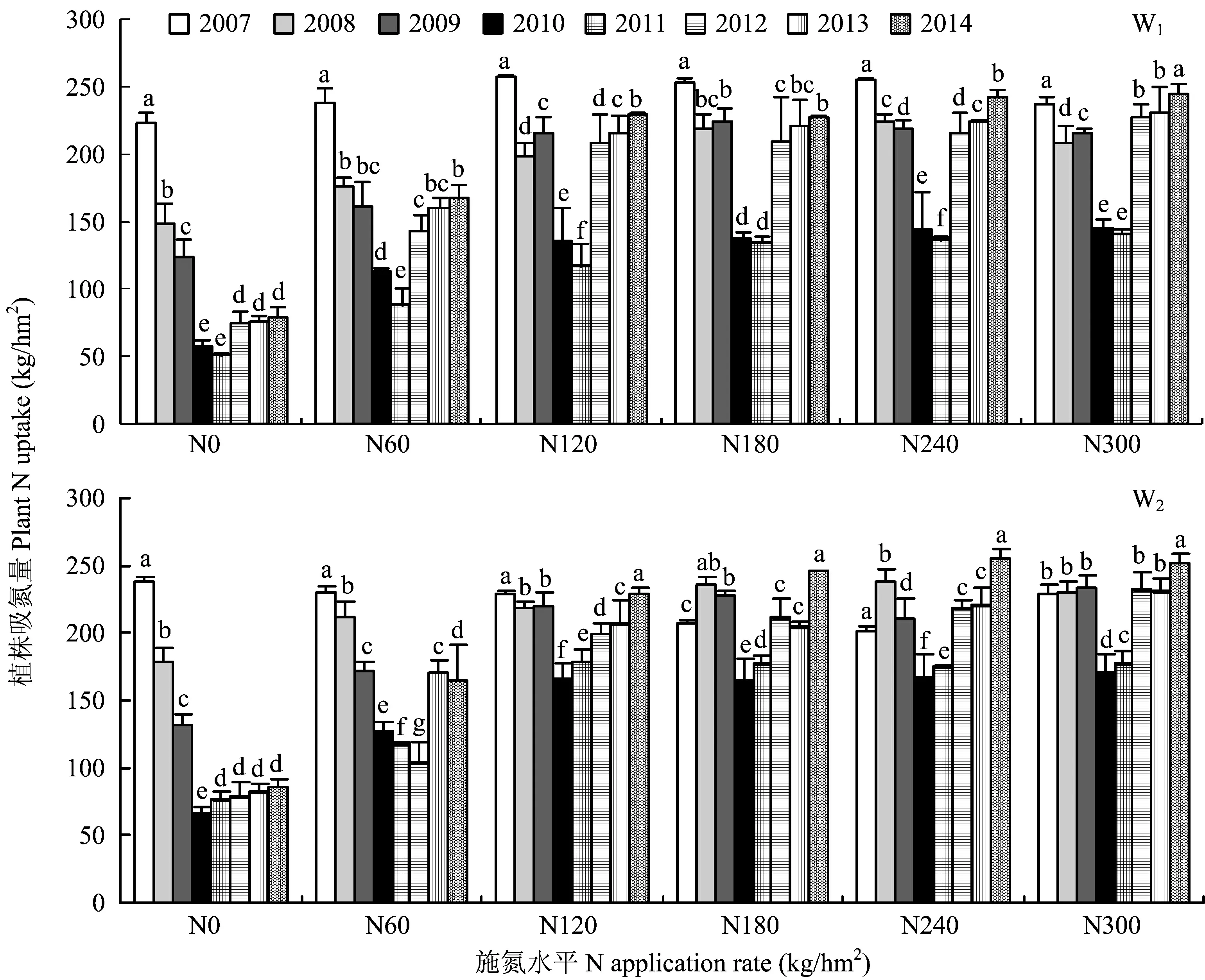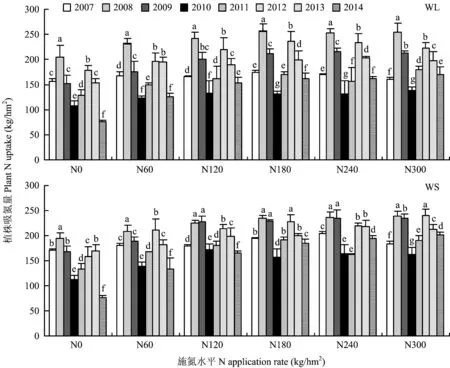冬小麦-夏玉米轮作产量与氮素利用最佳水氮配置
2016-08-24张经廷陈青云吕丽华申海平贾秀领梁双波
张经廷, 陈青云, 吕丽华, 申海平, 贾秀领*, 梁双波*
(1 河北省农林科学院粮油作物研究所, 农业部华北地区作物栽培科学观测实验站, 河北石家庄 050035;2 中国农业大学农学与生物技术学院, 北京 100193)
冬小麦-夏玉米轮作产量与氮素利用最佳水氮配置
张经廷1,2, 陈青云2, 吕丽华1, 申海平1, 贾秀领1*, 梁双波1*
(1 河北省农林科学院粮油作物研究所, 农业部华北地区作物栽培科学观测实验站, 河北石家庄 050035;2 中国农业大学农学与生物技术学院, 北京 100193)

冬小麦-夏玉米轮作; 水氮配置; 产量; 吸氮量; 氮肥利用效率
合理的水氮配置对作物生长发育和产量形成至关重要[1-2]。水氮存在明显的耦合效应[3-4],水分是养分的介质,水分适宜可提高氮肥利用率,干旱则限制作物对氮素的吸收[5-7]。适量施氮可有效调水,提高水分利用效率[8-10]。根据水氮对作物生长发育效应的不同,水氮耦合可分为三种具体类型,即加和效应(水氮互不影响)、 协同效应(水氮互相促进)和拮抗效应(水氮互相限制)[11]。作物生长过程中,如果水氮配置不合理不仅不能发挥水氮耦合协同效应,还会导致水氮资源的浪费[12-13],产生农业面源污染[14-15]。

1 材料与方法
1.1试验地概况
1.2试验设计
试验田耕作制度为冬小麦-夏玉米一年两熟秸秆还田少免耕耕作制度。试验为灌水、 施氮量和品种3因子裂区试验,灌水为主区,施氮量为副区,品种为副副区,小区面积为25.92 m2(4.8 m×5.4 m)。



表1 20062014年冬小麦和夏玉米各生长季供水量 (mm)
注(Note): W1—小麦在拔节期, 玉米为出苗期灌一次水One irrigation in jointing stage of wheat, or in seedling stage of maize; W2—灌两次水,小麦分别在拔节期和开花期, 玉米分别在出苗期和大喇叭口期灌水Twice irrigation in jointing and flowering stages of wheat, or in seedling and bumpet stages of maize; W3—灌三次水,玉米分别在出苗期、大喇叭口期和开花期灌水Three irrigations in seedling, bumpet and flowering stages of maize; WL—Limited irrigation for maize; WS—Suitable irrigation for maize.
1.3测定项目与方法
成熟期干物质量: 成熟期冬小麦每小区取2行长1 m的代表性样段,夏玉米每小区取5株代表性样株,取回后分秸秆和籽粒两部分,105℃烘箱中杀青30 min,75℃烘干至恒质量,称干物重,粉粹过2 mm筛,留样备用。
产量: 冬小麦采用小区联合收割机收获,谷物水分测定仪测定水分,折算为含水量13%的标准产量。夏玉米每小区收获玉米18 m2,数果穗数并称所有果穗总鲜重,计算平均鲜单穗重,根据平均鲜单穗重选取20穗,脱粒,谷物水分测定仪测定水分,折算为含水量14%的标准产量。
秸秆及籽粒全氮含量: 采用半微量凯氏定氮法测定。
1.4相关公式与数据分析
植株地上部吸氮量(kg/hm2)= 籽粒干物质量×籽粒含氮量+秸秆干物质量×秸秆含氮量
氮素收获指数(NHI)= 籽粒氮素积累量/植株地上部吸氮量
氮肥偏生产力(PEPN,kg/kg)=籽粒产量/施氮量
氮肥农学效率 (NAE, kg/kg)=(施氮区籽粒产量-不施氮区籽粒产量)/施氮量
氮素生产效率 (NUtE, kg/kg)= 籽粒产量/植株地上部吸氮量
氮肥累计表观利用率(AANRE, %)=(一定时期内施氮区小麦玉米植株地上部吸氮量之和-该时期不施氮区小麦玉米植株地上部吸氮量之和)/该时期的总施氮量×100
数据分析使用Microsoft Excel 2007,用SPSS 17.0软件进行单因素方差分析,采用最小显著差法进行处理间的多重比较(P<0.05)。
2 结果与分析
2.1两种水分条件下施氮水平对冬小麦夏玉米产量的影响

限水条件下各施氮水平夏玉米产量的年际变化也比较大,2008年和2012年产量最高,2010年产量最低; 不施氮处理的产量整体上低于施氮处理,施氮量≥120kg/hm2处理间的产量差异在各年度都不明显。适水条件下各施氮水平夏玉米产量的年际波动均比限水条件下小,稳产效果比较突出(图2)。
2.2两种水分条件下施氮水平对冬小麦、夏玉米植株吸氮量的影响


2.3冬小麦、 夏玉米产量与吸氮量的关系


图1 两种水分条件下不同施氮水平冬小麦产量Fig.1 Winter wheat yields under different N-fertilizer application rates in two irrigation treatments[注(Note):W1—在拔节期灌一次水 One irrigation in jointing stage; W2—分别在拔节期和开花期灌2次水 Twice irrigation in jointing and flowering stages.方柱上不同字母表示相同水分和施氮条件下,不同年份间小麦产量差异达5% 显著水平Different letters above the bars indicate significantly different among wheat yields in different years at the 5% level under the same irrigation and N conditions. ]
2.4两种水分条件下施氮水平对冬小麦夏玉米氮素利用的影响

限水和适水条件下夏玉米氮素利用对施氮水平的响应规律与冬小麦类似。各施氮水平夏玉米的平均植株吸氮量与冬小麦相差不大,但氮素收获指数显著低于冬小麦,可见玉米滞留于秸秆中的氮素比例显著高于小麦。不同施氮水平夏玉米的氮肥偏生产力、 氮素生产效率都高于冬小麦,但氮肥农学利用效率显著低于冬小麦(表3)。

图2 两种水分条件下施氮水平对不同年份夏玉米产量的影响Fig.2 Summer maize yields in different years under different irrigation and N-fertilizer rates[注(Note):WL—限水Limited water;WS—适水Suitable water. 方柱上不同字母表示相同水分和施氮条件下,不同年份间玉米产量差异达5% 显著水平Different letters above the bars indicate significantly different among maize yields in different years at the 5% level under the same irrigation and N conditions. ]

灌水Irrigation施氮水平Nrate产量Yield(kg/hm2)总吸氮量TotalNuptake(kg/hm2)NHIPFPN(kg/kg)NAE(kg/kg)NUtE(kg/kg)100kg籽粒吸氮量100kggrainNuptake(kg)1水W1N04815.9c106.1d0.78a48.1a2.12cN606651.9b154.6c0.77a110.9a30.6a43.9ab2.29bcN1207115.0a195.6b0.76a59.3b19.2b37.4bc2.71abN1807236.6a201.6ab0.77a40.2c13.4c36.7c2.76aN2407164.7a205.9a0.76a29.9d9.8d35.4c2.85aN3007210.6a204.7a0.76a24.0e8.0d35.7c2.81a平均Aver.6699.1178.10.7752.816.237.82.682水W2N05117.9c117.3d0.78a45.8a2.24bN607057.5b162.4c0.79a117.6a32.3a44.5a2.27bN1208238.5a206.0b0.78a68.7b26.0b40.2ab2.50abN1808341.5a209.4b0.75a46.3c17.9c40.1ab2.51abN2408211.3a211.0b0.75a34.2d12.9cd39.3b2.58aN3008371.6a219.6a0.75a27.9e10.8d38.4b2.62a平均Aver.7556.4187.60.7758.920.040.52.50
注(Note): NHI—氮素收获指数N harvest index; PFPN—氮偏生产力Partial fertilizer production efficiency; NAE—氮农学效率 N fertilizer agronomy efficiency; NUtE—氮生产效率 N utilization efficiency. 同列数值后相同字母表示相同灌水条件各处理在0.05水平上无显著性差异 Values followed by the same letters within a column are not significantly different among N treatments at the 0.05 probability level under the same irrigation condition.

图3 两种水分条件下不同施氮水平对不同年份冬小麦植株吸氮量Fig.3 N uptake of winter wheat under different N-fertilizer application and irrigation rates [注(Note):W1—在拔节期灌一次水 One irrigation in jointing stage;W2—分别在拔节期和开花期灌两次水 Twice irrigation in jointing and flowering stages.方柱上不同字母表示相同水分和施氮条件下,不同年份间小麦产量差异达5%显著水平Different letters above the bars indicate significantly different among wheat yields in different years at the 5% level under the same irrigation and N conditions. ]

灌水Irrigation施氮水平Nrate产量Yield(kg/hm2)总吸氮量TotalNuptake(kg/hm2)NHIPFPN(kg/kg)NAE(kg/kg)NUtE(kg/kg)100kg籽粒吸氮量(kg)100kggrainNuptake限水WLN07802.9c144.7d0.59a54.8a1.86dN608476.7b170.4c0.59a141.3a11.2a50.7b2.00cN1208819.7a183.2b0.58a73.5b8.5ab49.0bc2.07bcN1808948.5a192.6a0.56a49.7c6.4ab47.1c2.15abN2408837.6a190.6a0.54a36.8d4.3b47.2c2.16abN3008690.0ab192.0a0.56a29.0e3.0b45.9c2.21a平均Aver.8595.9178.90.5766.16.749.12.07适水WSN07663.7c148.0d0.57a52.5a1.93dN608824.4b181.4c0.57a147.1a19.3a49.3b2.05cdN1209298.0a195.6b0.56a77.5b13.6b47.8bc2.11bcN1809278.9a202.5ab0.57a51.5c9.0c46.2cd2.19abN2409288.0a206.3a0.55a38.7d6.8c45.8cd2.23abN3009257.6a210.6a0.57a30.9e5.3c44.6d2.28a平均Aver.8935.1190.70.5769.110.847.72.13
注(Note): NHI—氮素收获指数N harvest index; PFPN—氮偏生产力Partial fertilizer production efficiency; NAE—氮农学效率 N fertilizer agronomy efficiency; NUtE—氮生产效率 N utilization efficiency. 同列数值后标以相同字母表示相同灌水条件下各处理在0.05水平上无显著性差异 Values followed by the same letters within a column are not significantly different among N treatments at the 0.05 probability level under the same irrigation condition.

图4 两种水分条件下施氮水平对不同年份夏玉米植株吸氮量Fig.4 N uptake of summer maize under different N-fertilizer application and irrigation rates[注(Note):WL—限水Limited water;WS—适水Suitable water. 方柱上不同字母表示相同水分和施氮条件下,不同年份间玉米产量差异达5% 显著水平Different letters above the bars indicate significantly different among maize yields in different years at the 5% level under the same irrigation and N conditions. ]

图5 冬小麦、 夏玉米产量与植株吸氮量的相关性分析Fig.5 Correlation between the yields and plant N uptakes of winter wheat and summer maize
2.5两种水分条件下施氮水平对冬小麦-夏玉米轮作体系氮肥累计表观利用率的影响


图6 两种水分条件下施氮水平对冬小麦-夏玉米轮作体系氮肥累计表观利用率的影响Fig.6 Effect of N-fertilizer rates on accumulative apparent N-fertilizer recovery efficiency(AANRE) of wheat-maize rotation system under two water supply conditions[注(Note): 柱上标以不同小写字母表示同一水分条件下在0.05水平上有显著性差异(P<0.05) Different letters above the bar mean significant differences at the 0.05 probability level under the same irrigation condition.]
3 讨论


利用常规差减法计算作物氮肥表观利用率的前提为试验开始前各小区土壤肥力一致。然而,长期定位试验连续多年不同施氮处理已导致小区间土壤肥力水平存在很大差异。因此,利用常规差减法按年度或作物计算长期定位试验的氮肥利用率存在一定的不合理性。 累计氮肥利用率是指一段时期内作物吸收的肥料氮量与该时期施入土壤中的肥料氮总量的比值,它可以消除小区肥力和年际间的差异以及肥料的后效,在小麦-玉米轮作体系多年定位试验中得到广泛应用[29-30]。本研究8年定位试验结果表明,冬小麦-夏玉米轮作体系氮肥累计表观利用率随施氮量的增加显著下降,两种水分条件下N60+60处理作物氮肥累计表观利用率都高达50%以上,而N300+300处理则下降为20%左右。
本研究8年的定位试验中,施氮120 kg/hm2时冬小麦和夏玉米产量、 吸氮量都达到最高水平,氮肥偏生产力、 农学效率、 累积表观利用率以及氮素生产效率也比较高,进一步增加施氮量产量和吸氮量不再显著增加,反映氮肥利用效率的各项指标也都显著降低。两种水分条件下施氮120 kg/hm2作物籽粒氮素携出量8年平均值冬小麦为154.7 kg/hm2,夏玉米为107.9 kg/hm2,也就是说不考虑氮肥损失及环境供氮,冬小麦氮素携出量大于施氮量,土壤氮素亏缺; 夏玉米氮素携出量小于施氮量,土壤氮素盈余。巨晓棠等[31]利用15N同位素示踪肥料氮在冬小麦季去向的研究结果也表明,施氮120 kg/hm2时冬小麦吸收的氮素中来自土壤的量大于肥料氮残留于土壤中的量,对土壤氮肥力是一个耗竭过程。而冬小麦-夏玉米轮作体系中,冬小麦根系发达可有效利用前茬玉米季残留的肥料氮[32-33],因此,该轮作体系进行水氮配置时,应把两季作为一个整体,不仅要考虑作物产量、 吸氮量和氮素利用,同时也要兼顾对土壤氮素平衡和肥力的影响。该轮作体系中不同水氮条件下土壤肥力的长期变化趋势需要进一步研究。
4 结论

[1]山仑, 邓西平, 张岁岐. 生物节水研究现状及展望[J]. 中国科学基金, 2006, 20(2): 66-71.
Shan L, Deng X P, Zhang S Q. Advances in biological water-saving research: challenge and perspectives[J]. Bulletin of National Natural Science Foundation of China, 2006, 20(2): 66-71.
[2]朱兆良. 中国土壤氮素研究[J]. 土壤学报, 2008, 45(5): 778-783.
Zhu Z L. Research on soil nitrogen in China[J]. Acta Pedologica Sinica, 2008, 45(5): 778-783.
[3]金轲, 汪德水, 蔡典雄, 等. 水肥耦合效应研究Ⅰ.不同降雨年型对N、 P、 水配合效应的影响[J]. 植物营养与肥料学报, 1999, 5(1): 1-7.
Jin K, Wang D S, Cai D X,etal. Response and interaction for water and fertilizerⅠ. Interaction of N, P and water in the year of different precipitations[J]. Plant Nutrition and Fertilizer Science, 1999, 5(1): 1-7.
[4]王绍华, 曹卫星, 丁艳锋, 等. 水氮互作对水稻氮吸收与利用的影响[J]. 中国农业科学, 2004, 37(4): 497-501.
Wang S H, Cao W X, Ding Y F,etal. Interactions of water management and nitrogen fertilizer on nitrogen absorption and utilization in rice[J]. Scientia Agricultura Sinica, 2004, 37(4): 497-501.
[5]曹翠玲, 李生秀. 水分胁迫和氮素有限亏缺对小麦拔节期某些生理特性的影响[J]. 土壤通报, 2003, 34(6): 505-509.
Cao C L, Li S X. Effects of water stress and nitrogen deficiency on some physiological characteristics and wheat yield at the jointing stage[J]. Chinese Journal of Soil Science, 2003, 34(6): 505-509.
[6]樊小林, 李玲, 何文勤, 等. 氮肥、 干旱胁迫、 基因型差异对冬小麦吸氮量的效应[J]. 植物营养与肥料学报, 1998, 4(2)9: 131-137.
Fan X L, Li L, He W Q,etal. Effects of nitrogen fertilizer, water stress and the genotypes on nitrogen uptake of winter wheat[J]. Plant Nutrition and Fertilizer Science, 1998, 4(2): 131-137.
[7]张秋英, 李发东, 高克昌, 等. 水分胁迫对冬小麦光合特性及产量的影响[J]. 西北植物学报, 2005, 25(6): 1184-1190.
Zhang Q Y, Li F D, Gao K C,etal. Effects of water stress on the photosynthetic capabilities and yield of winter wheat[J]. Acta Botanica Boreali-Occidentalia Sinica, 2005, 25(6): 1184-1190.
[8]许旭旦. 旱作农业中的合理施肥及其生理学基础[J]. 干旱地区农业研究, 1985, 1(2): 56-71.
Xu X D. Rational fertilization and the basis of physiology in rain-field agriculture[J]. Agricultural Research in the Arid Areas, 1985, 1(2): 56-71.
[9]关军峰, 李广敏. 干旱条件下施肥效应及其作用机理[J]. 中国生态农业学报, 2002, 10(1): 59-61.
Guan J F, Li G M. Effects and mechanism of fertilization under drought[J]. Chinese Journal of Eco-Agriculture, 2002, 10(1): 59-61.
[10]谢英荷, 栗丽, 洪坚平, 等. 施氮与灌水对夏玉米产量和水氮利用的影响[J]. 植物营养与肥料学报, 2012, 18(6): 1354-1361.
Xie Y H, Li L, Hong J P,etal. Effects of nitrogen application and irrigation on grain yield, water and nitrogen utilization of summer maize[J]. Plant Nutrition and Fertilizer Science, 2012, 18(6): 1354-1361.
[11]Wallance A. Interactions of two parameters in crop production and in general biology: sequential additivity, synergism, antagonism[J]. Journal of plant nutrition, 1990, 13(3&4): 327-342.
[12]朱兆良. 农田中氮肥的损失与对策[J]. 土壤与环境, 2000, 9(1): 1-6.
Zhu Z L. The loss of nitrogen in farmland and countermeasures[J]. Soil and Environment, 2000, 9(1): 1-6.
[13]Terry A H. Enhancing water use efficiency in irrigated agriculture[J]. Agronomy Journal, 2001, 93: 281-289.
[14]Zhang W L, Tian Z X, Zhang N,etal. Nitrate pollution of groundwater in Northern China[J]. Agriculture, Ecosystems and Environment, 1996, 59: 223-231.
[15]Andraski T W, Bundy L G, Brye K R. Crop management and corn nitrogen rate effects on nitrate leaching[J]. Journal of Environmental Quality, 2000, 29: 1095-1103.
[16]王会肖, 刘昌明. 华北平原水资源供需与作物水分利用效率指征分析[J]. 生态农业研究, 1999, 7(3): 11-15.
Wang H X, Liu C M. Supply and demand of water resources and analysis of crop water use efficiency in the North China Plain[J]. Eco-agriculture Research, 1999, 7(3): 11-15.
[17]Chen X P. Optimization of the N fertilizer management of a winter wheat/summer maize rotation system in the Northern China Plain [D]. Stuttgart: PhD dissertation University of Hohenheim, Germany, 2003.
[18]赵荣芳, 陈新平, 张福锁. 华北地区冬小麦-夏玉米轮作体系的氮素循环与平衡[J]. 土壤学报, 2009, 46(4): 684-687.
[19]Zhu Z L, Chen D L. Nitrogen fertilizer use in China-Contributions to food production, impacts on the environment and best management strategies[J]. Nutrient Cycling in Agroecosystems, 2002, 63: 117-127.
[20]徐杰, 陶洪斌, 宋庆芳, 等. 水氮配置对华北冬小麦-夏玉米种植体系氮素利用及土壤硝态氮残留的影响[J]. 华北农学报, 2011, 26(4): 153-158.

[21]李志勇, 陈建军, 王璞. 不同水氮优化组合模式对冬小麦产量形成及水氮资源利用效率的影响[J]. 华北农学报. 2005, 20(2): 66-71.
Li Z Y, Chen J J, Wang P. Effects of the different irrigation-fertilization optimization models on grain yield, yield structure and water and nitrogen use efficiency of winter wheat[J]. Acta Agriculturae Boreali-Sinica, 2005, 20(2): 66-71.
[22]Liu M Q, Yu Z Q, Liu Y H,etal. Fertilizer requirements for wheat and maize in China: the QUEFTS approach[J]. Nutrient Cycling in Agroecosystems, 2006, 74(3): 245-258.
[23]Xu X P, He P, Pampolino M F,etal. Nutrient requirements for maize in China based on QUEFTS analysis[J]. Field Crops Research, 2013, 150: 115-125.
[24]张福锁, 王激清, 张卫峰, 等. 中国主要粮食作物肥料利用率现状与提高途径[J]. 土壤学报, 2008, 45(5): 915-924.
Zhang F S, Wang J Q, Zhang W Fetal. Nutrient use efficiencies of major cereal crops in China and measures for improvement[J]. Acta Pedologica Sinica, 2008, 45(5): 915- 924.
[25]He C E, Liu X J, Fangmeier Aetal. Quantifying the total air borne nitrogen input into agroecosystes in the North China Plain[J]. Agriculture, Ecosystems & Environment, 2007, 121: 395-400.
[26]郝卫平. 干旱复水对玉米水分利用效率及补偿效应影响研究[D]. 北京: 中国农业科学院博士学位论文, 2013.
Hao W P. Influence of water stress and rewatering on maize WUE and compensation effects [D]. Beijing: PhD Dissertation Chinese Academy of Agricultural Sciences, 2013.
[27]肖俊夫, 刘战东, 陈玉民. 中国玉米需水量与需水规律研究[J]. 玉米科学, 2008, 16(4): 21-25.
Xiao J F, Liu Z D, Chen Y M. Study on the water requirement and water requirement regulation of maize in China[J]. Journal of Maize Sciences, 2008, 16(4): 21-25.
[28]陈博, 欧阳竹, 程维新, 等. 近50a华北平原冬小麦-夏玉米耗水规律研究[J]. 自然资源学报, 2012, 27(7): 1186-1199.
Chen B, Ou Y Z, Chen W X,etal. Water consumption for winter wheat and summer maize in the North China Plain in recent 50 years[J]. Journal of Natural Resources, 2012, 27(7): 1186-1199.
[29]杨宪龙, 路永莉, 李茹, 等. 小麦-玉米轮作体系多年定位试验中作物氮肥利用率计算方法探讨[J]. 应用生态学报, 2014, 25(12): 3514-3520.
Yang X L, Lu Y L, Tong Y A,etal. Discussion on the calculation method of nitrogen use efficiency (NUE) in long term field experiments under wheat and maize rotation systems[J]. Chinese Journal of Applied Ecology, 2014, 25(12): 3514-3520.
[30]宇万太, 姜之绍, 赵鑫, 等. 不同施肥制度对肥料利用率的影响[J]. 土壤通报, 2009, 40 (1): 122-126.
Yu W T, Jiang Z S, Zhao X,etal. Effect of different fertilization system on fertilizer utilization efficiency[J]. Chinese Journal of Soil Science, 2009, 40 (1): 122-126.
[31]巨晓棠, 张福锁. 关于氮肥利用率的思考[J]. 生态环境, 2003, 12(2): 192-197.
Ju X T, Zhang F S. Thinking about nitrogen recovery rate[J]. Ecology and Environment, 2003, 12(2): 192-197.
[32]张经廷, 王志敏, 周顺利. 夏玉米不同施氮水平土壤硝态氮累积及对后茬冬小麦的影响[J]. 中国农业科学, 2013, 46(6): 1182-1190.
Zhang J T, Zhou S L, Wang Z M. Soil nitrate-N accumulation under different N-fertilizer rates in summer maize and its residual effects on subsequent winter wheat[J]. Scientia Agricultura Sinica, 2013, 46(6): 1182-1190.
[33]Wu Y C, Zhou S L, Wang Z M,etal. Recovery of residual fertilizer-nitrogen by wheat in a winter wheat-summer maize rotation in the North China Plain: A soil column study[J]. Agronomy Journal, 2009, 101: 925-932.
Optimum combination of irrigation and nitrogen for high yield and nitrogen use efficiency in winter wheat and summer maize rotation system
ZHANG Jing-ting1, 2, CHEN Qing-yun2, LÜ Li-hua1, SHEN Hai-ping1, JIA Xiu-ling1*, LIANG Shuang-bo1*
(1InstituteofCerealandOilCrops,HebeiAcademyofAgricultureandForestrySciences/ScientificObservingandExperimentalStationofCropCultivationinNorthChina,MinistryofAgriculture,Shijiazhuang050035,China; 2CollegeofAgronomyandBiotechnology,ChinaAgriculturalUniversity,Beijing100193,China)
【Objectives】 Inappropriate management of irrigation and fertilization is common in the winter wheat-summer maize rotation system in the piedmont plain of Taihang Mountain. Overuse of fertilizers and irrigation result in severe waste of water resources and agricultural non-point source pollution. Study on the appropriate water and nitrogen combination for high yields and N-fertilizer utilization will be necessary for profitable and sustainable agricultural production in winter wheat and summer maize rotation system in the region. 【Methods】 A two-factor complete split plot field experiment was conducted for 8 successive years. The main plots were irrigation volumes: one irrigation in jointing stage (W1) and twice in jointing and flowering stages (W2) for wheat, limited water (WL) and suitable water (WS) for maize. Subplots were consist of six N rates: 0(N0), 60(N60), 120(N120), 180(N180), 240(N240) and 300(N300) kg/hm2. The yields and plant N uptakes of wheat and maize were measured. 【Results】 The annual yields and N uptakes of wheat and maize varied significantly in all treatments. The annual differences of the yields and N uptakes were smaller in W2and WS treatments than in W1and WL ones for all the six N rates. Whatever the irrigation treatments, the yields and N uptakes in N0and N60treatments generally were significantly lower than in the other ones. In the yield levels of 7.0-9.5 t/hm2for winter wheat and 8.5-11.0 t/hm2for summer maize, the grain yields were significantly and positively correlated with the N uptakes. 8-years’ average of yields and N uptakes in both wheat and maize were increased significantly with increased N rates, but no significant increase in yields when N rate exceeded 120 kg/hm2for yields nor in N uptake when N rate exceeded 180 kg/hm2. For the same N rate, the crop yields and N uptakes in W2or WS were higher than in W1and WL. Under the two irrigation conditions, the partial factor productivities from N-fertilizer (PFPN), N-fertilizer agronomic efficiency (NAE) and nitrogen utilization efficiency (NUtE) were reduced obviously with the increase of N fertilizer rate. In the same N rate, all the three indices in W2and WS were higher than in W1and WL. The accumulative apparent N-fertilizer recovery efficiencies (AANRE) in the wheat-maize rotation system were also decreased obviously with the increase of N rates. Under the condition of W1+WL, the AANREs were decreased from 51.8% in N60+60to 22.3% in N300+300, and from 57.4% to 24.6% for W2+WS. For the same N rate, the AANRE under W2+WS was higher than that under W1+WL. 【Conclusions】 The peak yields and N uptakes are obtained with twice irrigation plus N rate of 120 kg/hm2for wheat and suitable irrigation plus N 120 kg/hm2for maize, and the partial production efficiency, agronomy efficiency and the cumulative agronomy efficiency of N fertilizer are all maintained at higher level. Therefore, under the annual grain yield target of 16-19 t/hm2, the optimal combination of water and nitrogen for winter wheat and summer maize is twice irrigation plus N 120 kg/hm2in the piedmont plain of Taihang Mountain over a certain period of time.
wheat-summer maize rotation; water and nitrogen combination; yield; plant N uptake;nitrogen use efficiency
2015-06-20接受日期: 2015-08-21
国家粮食丰产科技工程(2013BAD07B05, 2011BAD16B08); 公益性行业(农业)科研专项项目( 201303133)资助。
张经廷(1984—),男,山东菏泽人,博士后,主要从事作物栽培生理与土壤养分资源管理研究。E-mail: jingting58@126.com
Tel: 0311-87670620, E-mail: jiaxiuling2013@163.com; E-mail: L2208@163.com
S344.1; S143.1
A
1008-505X(2016)04-0886-11
